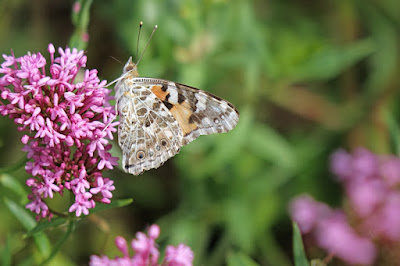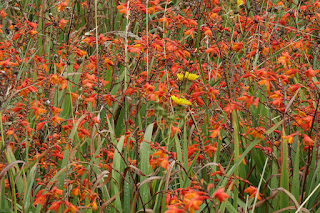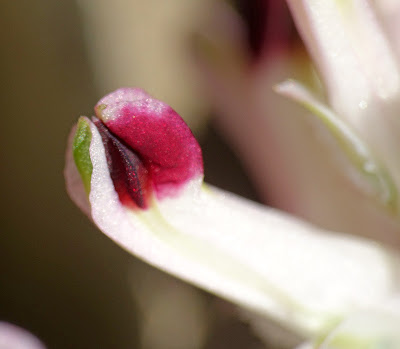It's been a month or so since we moved to this area from Kent, and it seemed like the chores resulting from moving house would never end. This was much like the wind and rain with weeks on end of rather autumnal weather, including three named storms in a week ( so I bought some wellies too).
Since then though, the weather has settled down and we are into the second week now of beautiful Spring sunshine under a high pressure weather system. As such, I have finally been able to get out and see what I can find in my local area of botanical interest.
One thing that was quickly apparent was that most fields were set aside for pasture for cattle and sheep with a grass monoculture and nothing much else in it. Many other fields don't grow crops for food either, like this field of Daffodils near St Ives. Apparently, Cornwall is a top exporter of Daffs, and also supplies all the UK with them too. Unfortunately, the farmer (as ever) sprays everything else in his field to oblivion, even right up to the road. Would some "weeds" along the edges really impact his Daffodil crop? I think not. I wonder why some (not all) farmers seem to hate nature so much?
My first proper trip was to Sladesbridge near Wadebridge, only a mile or so from my home, picked at random from the OS map. Unknown to me, this was actually a prime site for later in the year with several rare and interesting plants. More on those later in the year and at the end of this blog.
Meanwhile, I took a walk along the River Allen and the adjoining disused and overgrown railway line (now a young woodland). Due to the damp weather, ferns abound in Cornwall, so I'm having to learn more about these too. Here's what I found.
On a garden centre wall was a Rustyback Fern, so called due to the dense mat of rust coloured spores on the underside. An easy one to identify.
Asplenium ceterach
Even the Ivy is different here to Kent. Above is Atlantic Ivy (Hedera hibernica) which is usually a garden escape in Kent.
The underside of Rustyback Fern showing the dense spores.
Maidenhair Spleenwort is another wall fern that is common here. I now know there are three sub species, each with slightly different leaf arrangements. However, in Cornwall, we only get this one (though I will look for others just in case). These have a black stem (rachis) so are easy to remember.
Asplenium trichomanes subspecies quadrivalens
The odd looking round leaves above, belong to Navelwort, a very common plant here on almost every wall, that flowers from April onwards.
I then found my first "proper" flowering plant, the familiar Opposite-leaved Golden Saxifrage. This forms a gold studded carpet of tiny flowers on a sea of light green plants, but only in permanently damp or wet areas, usually by a stream, bog or pool.
There is an alternate leaved version but that isn't found in Cornwall.
Chrysosplenium oppositifolium
Spring isn't Spring without Lesser Celandines. As I write this in late March, there are now carpets of yellow flowers adorning every road verge and most lawns too. A very cheerful plant that opens with the sun and closes up at night or in bad weather.
Ficaria verna
I then came across a clump of Snowdrops in flower. It was a hybrid type sold by garden centres and I think they were likely planted even though they were not near a house or garden. My theory is that when a pet dies the owner may plant something like this on their favourite walk as a memorial to them. There were lots of dogs being walked here, so quite possible.
This Snowdrop is distinctive as it has a large green heart within the flower. Could of called it "For the Love of Spring". Of course, Snowdrop flowers hang down, so I got quite muddy taking this photo!
Galanthus nivalis x plicatus = G. x valentinei
Barren Strawberries were now coming into flower too with their tiny white petals failing to touch each other and with its matt green leaves without a central point. I mention those things as Wild Strawberry (the rarer strawberry) has the opposite of them with petals crowding and touching, glossy green leaves with a central point. Keep your eyes peeled as they are coming up now too!
Potentilla sterilis
Back to ferns! I couldn't help but notice some beautiful and impressive ferns arising from a central point and fanning out like a shuttlecock. There were a number of them and I have since seen them elsewhere too, quite common here. I took photos and a close look of every part of the fern and identified it as the Golden (or Scaly) Male Fern, very impressive and up to 4 feet tall.
Dryopteris affinis s.s.
The easiest feature to remember them by is to look for the black blotch at the base of the pinnae.Some views of the walk.
The young woodland still in its Winter state with no leaves on the trees as yet.
River Allen
It's whole catchment area is an SSSI and runs into the River Camel just south of Wadebridge.
Hypericum linariifolium
The rare plant found here later in the year is Toadflax-leaved St John's Wort, a species I'd not heard of before. Here's an image from the internet with credit to Len Worthington whose image I borrowed. Its quite rare (near threatened) and only found in the SW of England. It's in danger of dying out here as the young woodland will shade it out soon.
Spring has truly sprung and the next blog with my latest finds from Cornwall will follow soon.
Regards Dave
Follow me on Twitter @Botany2021








































